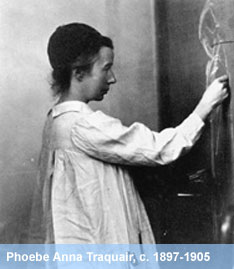
|
|
|
PHOEBE ANNA TRAQUAIR (1852 - 1936) Phoebe Anna Traquair was a leading artist of the Arts and Crafts movement in Scotland at the turn of the century. Her work was often based on lyrical, mythological or historical events that she reinterpreted in her mural decorations, paintings, book bindings, jewellery, enamelling, embroidery, manuscript illumination and lettering. Prominent examples of lettering are her illutrations for Elizabeth Barrett Browning's Sonnets from the Portuguese; Rosetti's Blessed Damozel and The House of Life; and Dante's Vita Unana. In Phoebe's early sketches of her two sons, one can sense her intuitive understanding of the differing natures of the boys. She describes Harry (left) as the "long headed silent boy who takes in all and gives out like a sledge hammer", and Ramsay (right) as "the round headed dreamer who takes in only what he likes, wakens now and then and tells it". The decoration of the mortuary chapel of the Royal Hospital for sick children launched Phoebe as a professional artist. Many of her commissions were for Catholic churches in Edinburgh, and as a result, her eldest son, Ramsay, placed a great importance on the Catholic churches of Quebec in his own work as an arc hitectural historian. Phoebe Traquair was the first woman to be elected an honorary member of the Royal Scottish Academy, was also a member of the Edinburgh Arts and Crafts Club, the Guild of Woman Binders, and the Royal Society of Painters in Water Colours. As a member of the Social Union, Phoebe believed that modern art should un ite the past with the present and bear a moral message, thus creating a blend of Realism and Symbolism. Among her numerous friends and admirers were John Ruskin,
An admirer of Italian art and crafts, Phoebe would travel often to Florence, and after her husband's death, she travelled widely to Egypt, India, North Africa, and the south of France. Her son Ramsay was also an admirer of Italian culture, art, and architecture, and was directly influenced in this by his mother. Phoebe and Ramsay collaborated on several projects, including enamel settings and Renaissance metalwork, as well as on shell cups. In an article by A.F. Morris, "A Versatile Art Worker: Mrs. Traquair" (Studio 34, June 1905), the author comments on Phoebe's illuminated panel designs, printed panels, jewellery, bookbinding for psalms, Sonnets from the Portuguese, and enamel. A notable example of the collaboration between mother and son is Phoebe's enamel triptych for Lady Carmichael and Ramsay's house for Lord Carmi chael of Skirling, in Peeblesshire in 1905. This is brilliantly illuminated for the Carmichaels in a page from the manuscript La Vita Nuova (1900), combini ng a portrait of Sir Thomas Gibson Carmichael with Castlecraig in the background.
A Note on Sources: The information and images for the entry on Phoebe Anna Traquair are derived from Elizabeth Cummings seminal exhibition catalogue, Phoebe Anna Traquair, published by the Scottish National Portrait Gallery in 1993.
|
|
Digital Collectionspy; 2003, McGill
University
|
|
|
|
|
|
|
|
|
|
|
|
|